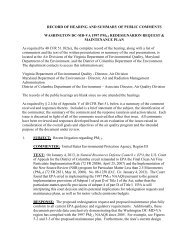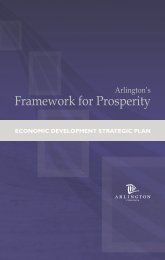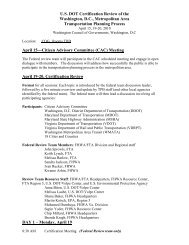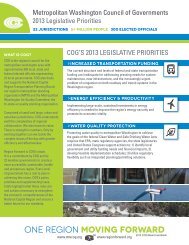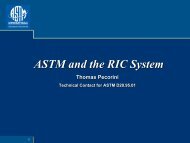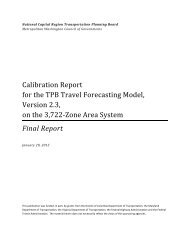PTI Local Government Energy Assurance Guidelines - Metropolitan ...
PTI Local Government Energy Assurance Guidelines - Metropolitan ...
PTI Local Government Energy Assurance Guidelines - Metropolitan ...
You also want an ePaper? Increase the reach of your titles
YUMPU automatically turns print PDFs into web optimized ePapers that Google loves.
<strong>Local</strong> Voices<br />
Asheville, North Carolina<br />
Getting to know and networking with your energy suppliers early in your planning process will help you<br />
understand what your suppliers’ capabilities are, and help you know what you can expect from them<br />
in terms of energy deliveries before an emergency strikes. By incorporating your key energy suppliers’<br />
contact information into your plan, you have information available immediately if an emergency strikes,<br />
and you have a relationship built on mutual trust.<br />
3.6.1 <strong>Local</strong> <strong>Energy</strong> Suppliers/Infrastructure Operators and Contracts<br />
Identifying energy suppliers is not as easy as it once was. It used to be possible to identify the energy supplier by<br />
simply looking at the energy bill. It was most likely that the same company that sent the bill was also the one that<br />
generated, transmitted, distributed, or otherwise delivered energy to the door step of the consumer.<br />
After the utility industry began to restructure (almost 20 years ago), local governments in some States had the option<br />
of opening up their systems to competition. Where they did, many local governments shopped around, comparing<br />
electricity prices and services and buying from the supplier who best met their needs. Services could be bundled or<br />
unbundled depending on how the State restructured. This competition brought new energy suppliers into the market,<br />
and with that came many more players and possible combinations of power suppliers. The upshot is that localities<br />
may now have multiple entities that provide energy, each delivering a different service.<br />
How might this new energy delivery model impact the EAP? The process, as a result, is more difficult. It is more<br />
important than ever to know who the key energy suppliers are, how they operate, what their capabilities and<br />
limitations are, and how they can assist with the EAP.<br />
Some of the energy suppliers to be aware of are: electric generating stations, owners/operators of related transmission<br />
and distribution lines, natural gas pipeline owners/operators and their associated storage and distribution network<br />
managers, and any local petroleum refinery and pipeline operators. Understanding renewable energy resources, smart<br />
grid investments, energy efficiency programs, and other similar initiatives, if present in the local jurisdiction, can<br />
also be an important part of energy assurance planning in an all-hazards environment.<br />
Identifying energy suppliers goes hand-in-hand with the energy profile work referred to in Step Four. Ideally,<br />
pertinent information has been entered into a user-friendly database that the energy assurance coordinator and<br />
working group can access easily. If this information is not already at hand, it should be collected during this phase of<br />
the planning process.<br />
Sources of electricity are usually investor-owned utilities (IOUs) and electric cooperative utilities (co-ops).<br />
Independent Power Producers (IPPs) are also key electricity suppliers to localities in some parts of the U.S. For most<br />
localities these utilities supply electricity from natural gas, coal, nuclear, and in some cases renewable sources (wind,<br />
geothermal, biomass, hydropower, and solar).<br />
As noted earlier, electricity generation and transmission and distribution services are not always performed by the<br />
same company. Electrical distribution is the final stage in the delivery of electricity to the locality. Therefore, getting<br />
<strong>Local</strong> <strong>Government</strong> <strong>Energy</strong> <strong>Assurance</strong> <strong>Guidelines</strong> – Version 2.0 | 47



